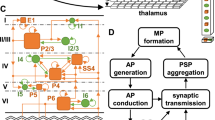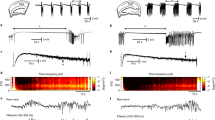Abstract
A tonic-clonic seizure transitions from high frequency asynchronous activity to low frequency coherent oscillations, yet the mechanism of transition remains unknown. We propose a shift in network synchrony due to changes in cellular response. Here we use phase-response curves (PRC) from Morris-Lecar (M-L) model neurons with synaptic depression and gradually decrease input current to cells within a network simulation. This method effectively decreases firing rates resulting in a shift to greater network synchrony illustrating a possible mechanism of the transition phenomenon. PRCs are measured from the M-L conductance based model cell with a range of input currents within the limit cycle. A large network of 3000 excitatory neurons is simulated with a network topology generated from second-order statistics which allows a range of population synchrony. The population synchrony of the oscillating cells is measured with the Kuramoto order parameter, which reveals a transition from tonic to clonic phase exhibited by our model network. The cellular response shift mechanism for the tonic-clonic seizure transition reproduces the population behavior closely when compared to EEG data.










Similar content being viewed by others
References
Abbott, L. F., Varela, J. A., Sen, K., & Nelson, S. B. (1997). Synaptic depression and cortical gain control [see comments]. Science, 275(5297), 220–224.
Achuthan, S., & Canavier, C. C. (2009). Phase-resetting curves determine synchronization, phase locking, and clustering in networks of neural oscillators. The Journal of Neuroscience: The Official Journal of the Society for Neuroscience, 29(16), 5218–5233.
Bragin, A., Engel, J., Jr., & Staba, R. J. (2010). High-frequency oscillations in epileptic brain. Current Opinion in Neurology, 23(2), 151–156.
Brown, E., Moehlis, J., & Holmes, P. (2004). On the phase reduction and response dynamics of neural oscillator populations. Neural Computation, 16(4), 673–715.
Buia, C., & Tiesinga, P. (2006). Attentional modulation of firing rate and synchrony in a model cortical network. Journal of Computational Neuroscience, 20(3), 247–264.
Dror, R. O., Canavier, C. C., Butera, R. J., Clark, J. W., & Byrne, J. H. (1999). A mathematical criterion based on phase response curves for stability in a ring of coupled oscillators. Biological Cybernetics, 80(1), 11–23.
Ermentrout, G. B., & Kleinfeld, D. (2001). Traveling electrical waves in cortex: insights from phase dynamics and speculation on a computational role. Neuron, 29(1), 33–44.
Ermentrout, G. B., & Kopell, N. (1998). Fine structure of neural spiking and synchronization in the presence of conduction delays. Proc Natl Acad Sci U S A, 95(3), 1259–164.
Ermentrout, G. B., Beverlin, B. 2nd, Troyer, T., & Netoff, T. I. (2011). The variance of phase-resetting curves. Journal of Computational Neuroscience
Fink, C. G., Booth, V., & Zochowski, M. (2011). Cellularly-driven differences in network synchronization propensity are differentially modulated by firing frequency. PLoS Computational Biology, 7(5), e1002062.
Fisch, J. F., & Olejniczak, P. W. (2006). Generalized-tonic-clonic seizures. In E. Wyllie, A. Gupta, & D. K. Lachhwani (Eds.), The treatment of epilepsy: Principles & practice (p. 279). Philadelphia: Lippincott Williams & Wilkins.
Garcia Dominguez, L., Wennberg, R. A., Gaetz, W., Cheyne, D., Snead, O. C., 3rd, & Perez Velazquez, J. L. (2005). Enhanced synchrony in epileptiform activity? local versus distant phase synchronization in generalized seizures. The Journal of Neuroscience: The Official Journal of the Society for Neuroscience, 25(35), 8077–8084.
Gastaut, H., & Broughton, R. J. (1972). Epileptic seizures; clinical and electrographic features, diagnosis and treatment. Springfield: Thomas.
Glass, L., & Mackey, M. C. (1988). From clocks to chaos: The rhythms of life. Princeton: Princeton University Press.
Goel, P., & Ermentrout, G. B. (2002). Synchrony, stability, and firing patterns in pulse-coupled oscillators. Physica D: Nonlinear Phenomena, 163(3–4), 191.
Hansel, D., Mato, G., & Meunier, C. (1995). Synchrony in excitatory neural networks. Neural Comput, 7(2), 307–37.
Hoppensteadt, F. C., & Izhikevich, E. M. (1997). Weakly connected neural networks. New York: Springer.
Izhikevich, E. M. (2007). Dynamical systems in neuroscience: The geometry of excitability and bursting. Cambridge: MIT.
Kopell, N., & Ermentrout, G. B. (2002). Mechanisms of phase-locking and frequency control in pairs of coupled neural oscillators. In B. Fiedler (Ed.), Handbook on dynamical systems (pp. 3–54). New York: Elsevier.
Kuramoto, Y. (1984). Chemical oscillations, waves, and turbulence. Berlin: Springer.
Lewis, T. J., & Rinzel, J. (2003). Dynamics of spiking neurons connected by both inhibitory and electrical coupling. Journal of Computational Neuroscience, 14(3), 283–309.
Mancilla, J. G., Lewis, T. J., Pinto, D. J., Rinzel, J., & Connors, B. W. (2007). Synchronization of electrically coupled pairs of inhibitory interneurons in neocortex. The Journal of Neuroscience: The Official Journal of the Society for Neuroscience, 27(8), 2058–2073.
Manor, Y., & Nadim, F. (2001). Synaptic depression mediates bistability in neuronal networks with recurrent inhibitory connectivity. J Neurosci, 21(23), 9460–9470.
Morris, C., & Lecar, H. (1981). Voltage oscillations in the barnacle giant muscle fiber. Biophysical Journal, 35(1), 193–213.
Neltner, L., Hansel, D., Mato, G., & Meunier, C. (2000). Synchrony in heterogeneous networks of spiking neurons. Neural Comput, 12(7), 1607–41.
Netoff, T. I., & Schiff, S. J. (2002). Decreased neuronal synchronization during experimental seizures. The Journal of Neuroscience: The Official Journal of the Society for Neuroscience, 22(16), 7297–7307.
Netoff, T. I., Clewley, R., Arno, S., Keck, T., & White, J. A. (2004). Epilepsy in small-world networks. The Journal of Neuroscience: The Official Journal of the Society for Neuroscience, 24(37), 8075–8083.
Netoff, T. I., et al. (2005). Synchronization in hybrid neuronal networks of the hippocampal formation. Journal of Neurophysiology, 93(3), 1197–1208.
Neu, J. (1979). Coupled chemical oscillators. SIAM J. Appl. Math., 37307–315.
Perez Velazquez, J. L., Garcia Dominguez, L., & Wennberg, R. (2007). Complex phase synchronization in epileptic seizures: Evidence for a devil's staircase. Physical Review.E, Statistical, Nonlinear, and Soft Matter Physics, 75(1 Pt 1), 011922.
Quian Quiroga, R., Blanco, S., Rosso, O. A., Garcia, H., & Rabinowicz, A. (1997). Searching for hidden information with gabor transform in generalized tonic-clonic seizures. Electroencephalography and Clinical Neurophysiology, 103(4), 434–439.
Rinzel, J. (1985). Excitation dynamics: Insights from simplified membrane models. Federation Proceedings, 44(15), 2944–2946.
Schindler, K., Elger, C. E., & Lehnertz, K. (2007). Increasing synchronization may promote seizure termination: evidence from status epilepticus. Clinical Neurophysiology: Official Journal of the International Federation of Clinical Neurophysiology, 118(9), 1955–1968.
Schindler, K., Leung, H., Elger, C. E., & Lehnertz, K. (2007). Assessing seizure dynamics by analysing the correlation structure of multichannel intracranial EEG. Brain: A Journal of Neurology, 130(Pt 1), 65–77.
Smeal, R. M., Ermentrout, G. B., & White, J. A. (2010). Phase-response curves and synchronized neural networks. Philosophical Transactions of the Royal Society of London.Series B, Biological Sciences, 365(1551), 2407–2422.
Song, S., Sjostrom, P. J., Reigl, M., Nelson, S., & Chklovskii, D. B. (2005). Highly nonrandom features of synaptic connectivity in local cortical circuits. PLoS Biology, 3(3), e68.
Strogatz, S. H. (2000). From Kuramoto to Crawford: exploring the onset of synchronization in populations of coupled oscillators. Physica D: Nonlinear Phenomena, 143(1–4), 1.
Tiesinga, P. H., & Sejnowski, T. J. (2004). Rapid temporal modulation of synchrony by competition in cortical interneuron networks. Neural Computation, 16(2), 251–275.
Varela, J. A., Sen, K., Gibson, J., Fost, J., Abbott, L. F., & Nelson, S. B. (1997). A quantitative description of short-term plasticity at excitatory synapses in layer 2/3 of rat primary visual cortex. J Neurosci, 17(20), 7926–740.
Ward, A. A. Jr. (1961). The epileptic neurone. Epilepsia, 270–280.
Watts, D. J., & Strogatz, S. H. (1998). Collective dynamics of 'small-world' networks. Nature, 393(6684), 440–442.
Winfree, A. T. (2001). The geometry of biological time. New York: Springer.
Zhao, L., Beverlin B. 2nd, Netoff, T., & Nykamp D. Q. (2011). Synchronization from second order network connectivity statistics. Frontiers in Computational Neuroscience, 528.
Ziburkus, J., Cressman, J. R., Barreto, E., & Schiff, S. J. (2006). Interneuron and pyramidal cell interplay during in vitro seizure-like events. Journal of Neurophysiology, 95(6), 3948–3954.
Acknowledgments
Thanks to Bard Ermentrout and Chris Warren for helpful discussions. Funding for this work provided by UMN Grant-In-Aid and NSF CAREER award.
Author information
Authors and Affiliations
Corresponding author
Additional information
Action Editor: David Terman
Rights and permissions
About this article
Cite this article
Beverlin, B., Kakalios, J., Nykamp, D. et al. Dynamical changes in neurons during seizures determine tonic to clonic shift. J Comput Neurosci 33, 41–51 (2012). https://doi.org/10.1007/s10827-011-0373-5
Received:
Revised:
Accepted:
Published:
Issue Date:
DOI: https://doi.org/10.1007/s10827-011-0373-5




